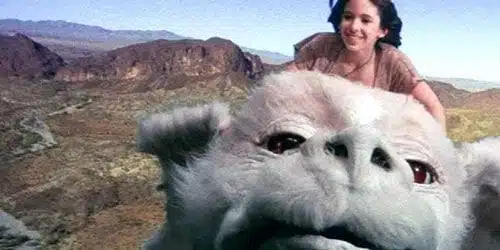
For many children of the ’80s, The Neverending Story is a major cornerstone of their early experiences with both cinema and the fantasy genre. Along with classics like The Princess Bride and The Dark Crystal, The Neverending Story became a familiar sight to kids of a certain era, due to its popularity on VHS and frequent inclusion in TV movie-marathons during the holidays. For those kids’ grown-up selves, however, The Neverending Story is often the forgotten member of the gang, lacking the big-kid humor of The Princess Bride or the darker, more adult tone of The Dark Crystal.
True, The Neverending Story does win the occasional Family Guy vignette and its characters are sometimes name-checked by rappers and indie-rockers, but usually it’s to mock the film’s unmistakably ’80s soundtrack and visual effects, or evoke ironic nostalgia for the simple believe-in-yourself spirit kids’ movies of the time promoted. That’s pretty appropriate though, given that The Neverending Story is, above all things, an archetypal example of the ’80s children’s adventure film.
The story begins in ’80s New York (though the film was actually produced in Germany and is loosely based on a book by German author Michael Ende). A young boy named Bastian is not having the easiest childhood, as we in the audience infer from the multiple ’80s clichés of a loving but overly-practical single father (“Keep your feet on the ground!”), Bastian’s inability to focus at school, and a gang of elementary-school bullies with an unlikely fondness for bad-puns who love to throw Bastian into dumpsters.
Escaping from these cartoon villians (at least none of them has a twirly mustache, though one wears a leather jacket) by ducking into a book store, the day-dreaming Bastian stumbles upon a mysterious volume entitled The Neverending Story. Though the store owner warns him that the book isn’t “safe”, Bastian swipes the old tome and decides to spend the day reading it instead of going to class and taking his math test.
The story Bastian starts to read forms the bulk of the movie. The magical land of Fantasia is fading away, consumed by an encroaching “Nothing” that no one knows how to stop. One of the people who doesn’t know how to stop it is a horse-riding boy from the plains called Atreyu, who is summoned by the Empress’ servant to help save the land. How he is supposed to do this no one can say, but he sets off on the quest anyway, desperate to save his home and the Empress, who grows sicker as Fantasia shrinks.
This is about all the explanation Atreyu and the audience gets for much of the movie. As adults we may be a bit confused as to why a small boy would take off on a very dangerous mission with no instructions just because some guy in a cape assures him that he must, and with no justification as to why a pre-adolescent is the right candidate for the job. On the other hand, Atreyu, Bastian, and all the other human kids watching this adventure understand that good must fight evil, however two-dimensionally defined. If it’s a kid who has to go off and be brave while all the adults sit around cringing, so much the better.
Atreyu wanders all over the land, meeting various magical creatures along the way. Some of them don’t make it, which is very sad. Again, there isn’t a lot of exposition allowing us to get to know these characters before something drastic happens to them, but that won’t matter to a child. When a horse dies, a child knows to cry.
Bastian’s new friends, especially a flying luckdragon (a puppet with a dragon’s body and a dog’s head) called Falkor, urge him to believe in himself no matter what, and so appropriately many of the trials he encounters on his way to saving the realm are basically just tests of his self-esteem. A giant-turtle and an evil wolf or two later, Atreyu gets to the bottom of what’s ailing Fantasia, a realization that pulls Bastian quite literally into the action.
It’s a simple enough plot, and one unlikely to excite most people over the age of 12, despite its meta-riffic resolution. Still, the film has some thrills for the older-crowd beyond pure camp value. The creatures that inhabit Fantasia are mostly represented by puppets, and while they may seem dated a quarter of a century later, many of them are unique even by fantasy standards, including a cycle-riding rock-monster and the cranky, ancient Morla.
The visual effects are pretty impressive as well, give or take the occasional sloppy green-screen moment or too-obvious puppet. The producers cleverly blend real European landscapes with prop-scenery and dramatic high-altitude aerial shots to create a striking setting for the story (and as one would expect from director Wolfgang Petersen, one that looks fantastic on Blu-ray). Much like the different races that inhabit it, the geography of Fantasia is a well-balanced blend of comfortable fantasy tropes and inspired, unique touches. It’s not an environment that’s too thoroughly explored, but the glimpses provided will be satisfying enough as long as the audience isn’t expecting The Silmarillion.
All in all, The Neverending Story is a silly fantasy movie that often shows its age, but as a kids’ movie it still has enough exciting action and you-can-do-it attitude to earn itself a place in a family’s DVD collection. Also, if you get it on Blu-Ray, you may find yourself watching it as much as the kids do.
